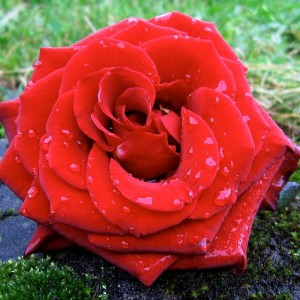
When giving cut roses as Valentine’s gifts, we adhere to a time-honored formula that takes into account rose color meanings. The formula matches a flower’s color to its intended meaning as a gift. Valentine’s Day is primarily a lovers’ holiday, and red is traditionally reserved for lovers. Red Valentine roses enjoy an iconic status, even though other colors have their place on the holiday. Our close family members may also be treated to red posies for Valentine’s Day, but we avoid this color choice for friends on Valentine’s Day — that would simply convey the wrong meaning. The following are the meanings traditionally ascribed to the most popular roses, according to colors:
- Red means romantic love (the “Valentine roses,” par excellence.)
- Purple, coral and orange challenge red as the color for Valentine roses. The rose color meanings for these 3 are as follows: The specific purpose of purple roses is to signify that the giver has fallen in love with the recipient at first sight. Meanwhile, coral signals desire. And orange roses, along with apricot, connote enthusiasm.
- The meaning of yellow roses is joy and friendship.
- We express our gratitude and appreciation with pink roses… While feelings of admiration and sympathy find words with roses that are light pink in color.
- Peach is more ambiguous, as it can signify either sympathy or gratitude.
- Their purity, naturally enough, lends white roses the meaning of reverence and humility.
But is growing Roses in the yard that simple? Just about.
The formula for growing rose bushes is a well-known one since it is a formula that the average landscape plant lives (or dies) by:
Sun + water + drainage + rich soil = rose success
I use the terminology “rose bushes” to refer generally to all roses, regardless of form, which can range from miniature shrubs to sprawling climbers. Once you’re committed to following the formula for growing rose bushes, for maximum success you’ll simply have to tweak the formula a bit and add some extras. For instance, while roses like six hours of sun per day, it does matter what part of the day those six hours come from. Six hours of morning sun is preferable to six hours of afternoon sun, for two reasons:
- Rosebush foliage prefers to be dry. The quicker the dampness from the night is burned off the foliage, the less likely the disease is to become a factor.
- The afternoon sun is often excessively hot. Roses profit from some afternoon shade.
How about pruning?
The proper tool for pruning rose bushes is a set of bypass pruners, not anvil pruners (the latter can crush the rose bush’s stem). Since rose bushes like to send out a strong lateral cane at the node just below a pruning cut, try to make pruning cuts about 1/4 inch above an “outward” facing leaf bud. By doing this and removing plant material from the center of the bush you will create a more open vase-shaped plant less susceptible to disease.
The principle behind deadheading roses is the same as it is for any other plant. Removing spent blooms from rose bushes is a way of channeling plant energy into areas where it is needed more.
Plant Information for Selecting Rose Bushes
Hybrid tea rose bushes and Knockouts are the most popular because they put out a big rose on a straight stem. Polyanthas produce dense clusters of small flowers on a dwarf rose bush. Floribunda rose bushes are a cross between the hybrid teas and the polyanthas. Grandifloras produce large rose clusters on long stems. Other options for rose bush growers include miniatures, climbers, tree roses and old-time varieties.
Don’t be intimidated by Roses. They are a great compliment to any landscape not to mention the availability of fresh cut Roses right outside your door!
Question: Jimmie, when is the correct time to prune my Lantana back? Thank you for your time. I have been wanting to ask you this for 3 years now! Janet P. in Prosper
Answer: Hi Janet, when your lantana’s leaves turn brown and the plant dies back to bare wood when freezing temperatures arrive, there’s not much point in waiting till spring before pruning. Take the opportunity to prune your lantana down by as much as to within 6-12 inches of ground level. Leaves will re-emerge in spring. Lantana isn’t harmed at all by such a drastic pruning, and the result will be a more compact lantana plant with many more blooms! Until next time…Happy Gardening!
Jimmie